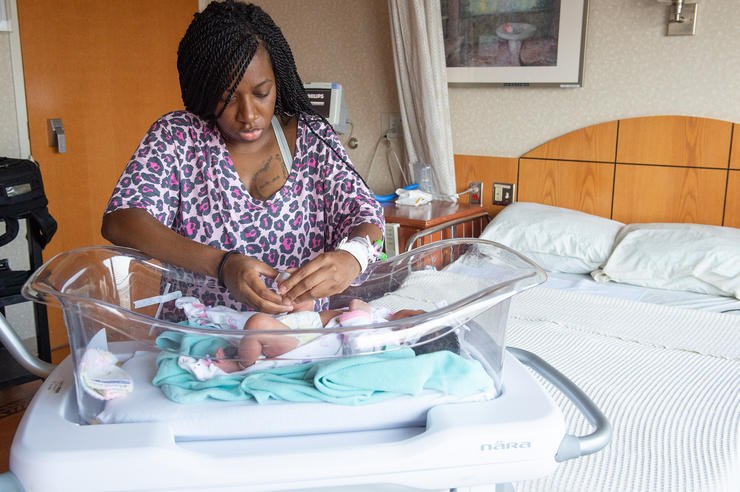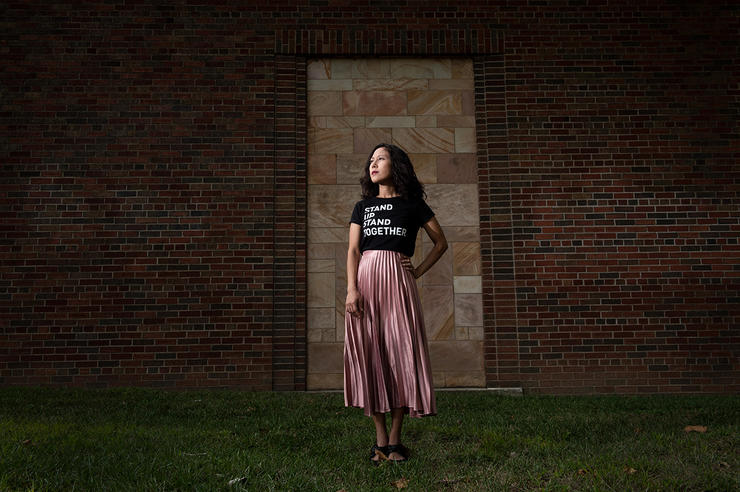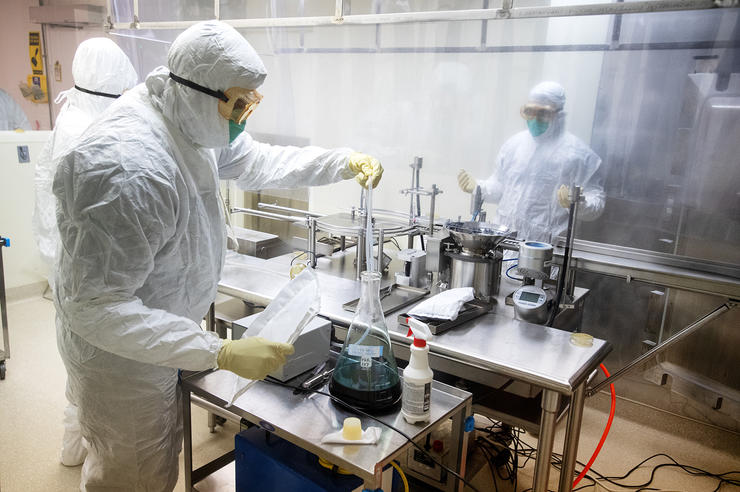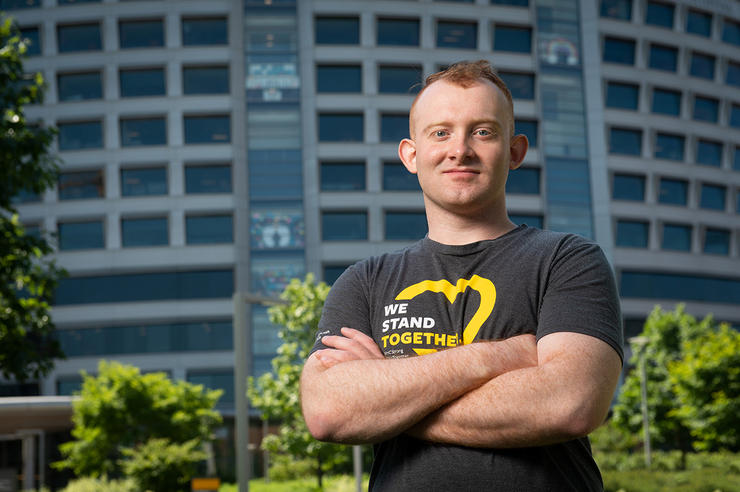Telehealth provides Iowans increased access to care
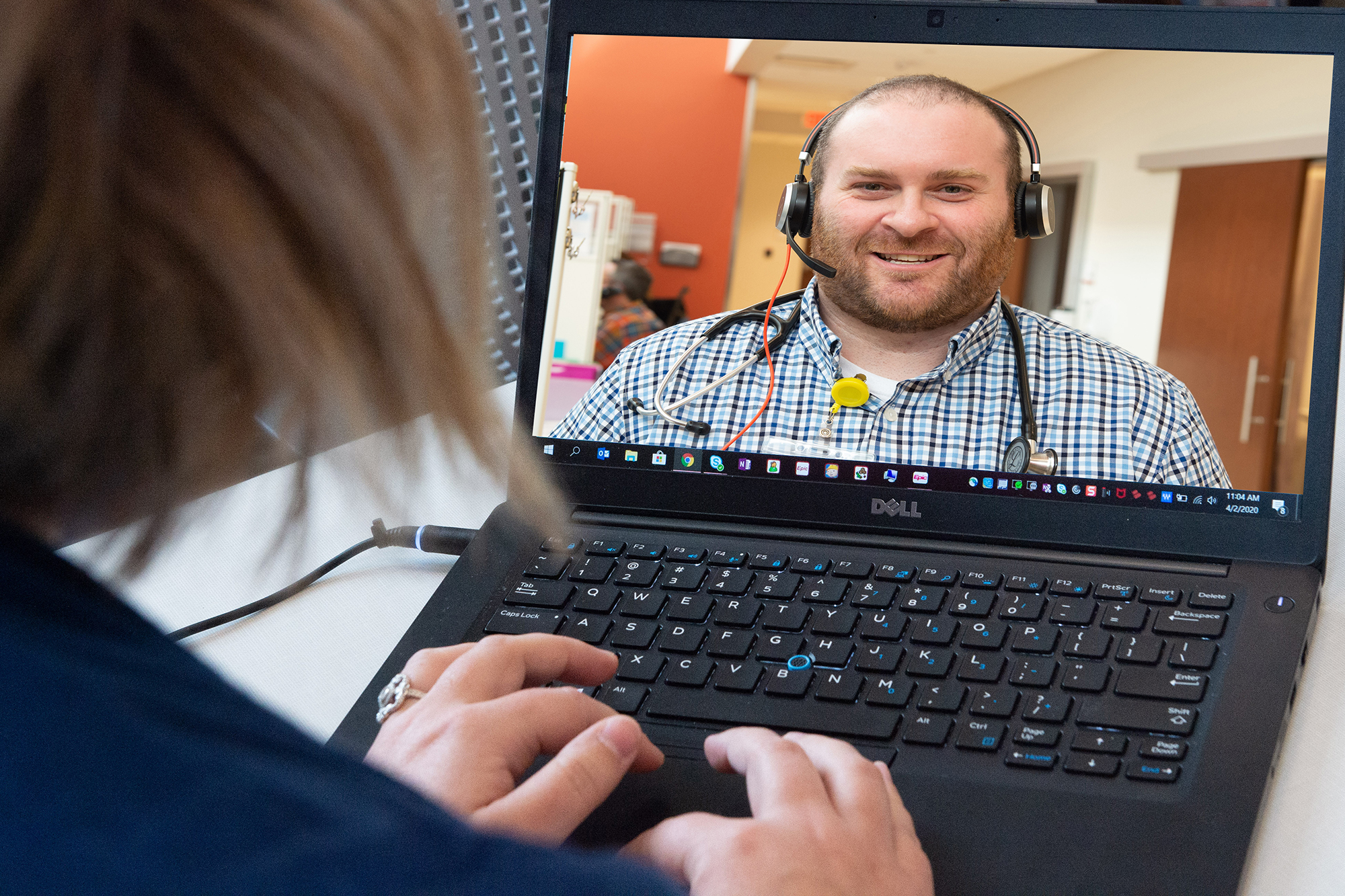
The COVID-19 pandemic has transformed life as we know it, but one change may have a silver lining for health care: the widespread adoption of telehealth.
Since March 2020, patients have met with their doctors, specialists, and therapists via computer, smartphone, and telephone. Along with mitigating the risk of spreading the virus, telehealth has ensured timely access to health care for millions of Americans—and thousands of Iowans.
In the past 13 months, University of Iowa Health Care has completed more than 231,000 telehealth visits. More than 40% of all UI Health Care telehealth visits involved care that was not for COVID-19-related illness.
“If there is any silver lining in COVID, it is that the rules were relaxed for telehealth,” says Denice Hodgson-Zingman, MD, cardiac electrophysiologist and director of electrophysiology. “There are still hurdles, but it’s opened the door. The ability to see a patient in their own home is huge, absolutely huge.”

Telehealth services were limited before COVID-19, largely due to rules related to health care payers’ reimbursement for them. The Centers for Medicare & Medicaid Services (CMS) has temporarily expanded the list of telehealth services it will pay for during the COVID-19 Public Health Emergency, which was renewed Jan. 21, 2021.
“We began doing telehealth for COVID symptoms—rather than have those patients come in to our clinics and potentially expose other patients and staff—before Medicare loosened the regulations,” says Beth Jaggers, administrative director of UI Physician Group at UI Health Care. “So we got a little ahead of the curve there.”
Now, all UI Health Care providers have the capability to perform a telehealth visit. And many hope that payers will realize the tremendous benefits that telehealth offers and continue to reimburse the services past the pandemic.
“I hope this is used as opportunity to see the power of telehealth and for it to be more widely accepted by payers as an efficient, cost-effective, and smart way to do medicine,” Hodgson-Zingman says. “I hope people will realize that in many circumstances, this is as effective as an in-person visit—and that in some cases it can be more powerful than an in-person visit.”
Accessibility is often cited as the main benefit of telehealth.
“When you’re the only comprehensive, tertiary-level care center in the state, it’s helpful for someone in, for example, Sioux City to be able to make connections from home first, before having to drive across the state—sometimes that is possible,” Jaggers says. “I can imagine them visiting with a specialist via telehealth, getting labs done locally, and then maybe the third visit is done at 200 Hawkins Drive in Iowa City.”
Jaggers says telehealth has proven effective in the care of patients with COVID-19, and that may be translated to other acute illnesses.
“In this contagious environment, we’ve learned people heal well at home and may not necessarily need to be admitted to the hospital,” Jaggers says. “But if they do, virtual home visits will recognize that. We’ve also had situations in which people have missed a telehealth appointment and when we couldn’t get ahold of them, facilitated a home visit to check on them. In a traditional clinic setting, we may not have had that type of relationship.”
“I hope this is used as opportunity to see the power of telehealth and for it to be more widely accepted by payers as an efficient, cost-effective, and smart way to do medicine. I hope people will realize that in many circumstances, telehealth is comparable to an in-person visit—and that in some cases it can be more powerful than an in-person visit.”
Jaggers also expects telehealth to improve preventive care for some people.
“When things become a little more convenient, it’s just easier to take care of yourself,” Jaggers says. “You are less likely to put it off if you can just click and see a health care provider through your mobile devices.”
UI Health Care patients appear to approve of telehealth, with 94% rating the experience “good” or “very good,” according to Press Ganey surveys. And there are high hopes for what telehealth will be able to do for patients and providers.
“If payers keep reimbursing for telehealth, I think it’s going to be the next really innovative thing you see coming out of health care,” Jaggers says. “The sky’s the limit. Most people have a scale and thermometer, but I think we’ll see more technology that allows us to gather vital health information from the comfort of our homes. Our home will become the clinic.”
Telehealth is being used to various degrees in every department at UI Hospitals & Clinics. Read ahead for examples of how providers are using telehealth in their specialty and what patients might expect during a telehealth visit.
Jump to:
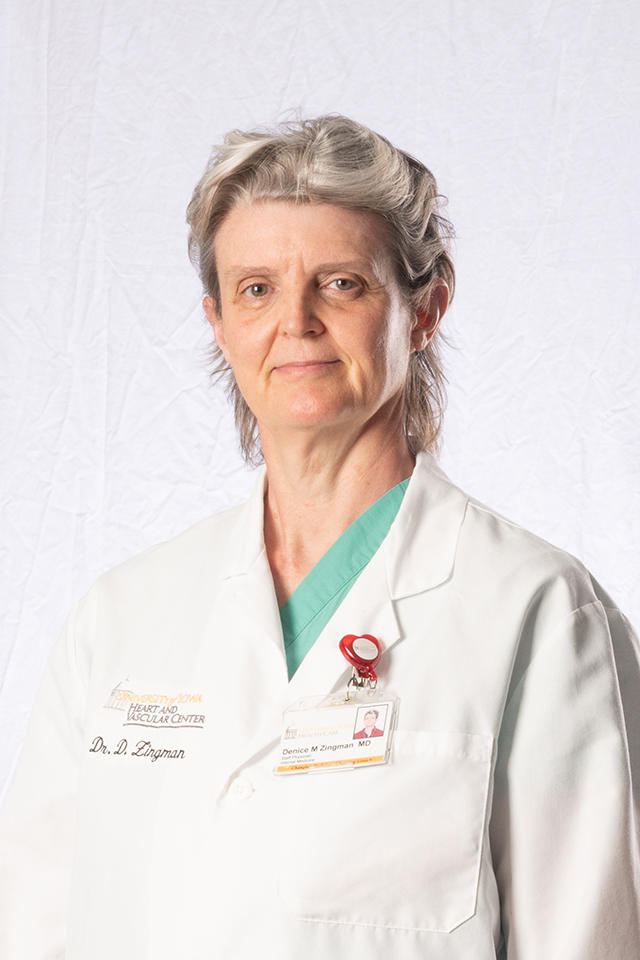
Electrophysiology
Denice Hodgson-Zingman, cardiac electrophysiologist and director of electrophysiology, says she and her colleagues had been trying to get telehealth going for cardiac care for years.
“We’ve been trying to crack this nut for a while now, but with prior Medicare rules we were limited and could only set up telehealth at Medicare hubs,” Hodgson-Zingman says. “And those weren’t always where our patients were. We needed telehealth in remote areas where there isn’t a nearby hub.”
COVID-19 gave them the opportunity to do just that. Not all Iowans have local access to an electrophysiologist, but telehealth can bring specialized care to them. Even for local patients, it can sometimes alleviate potential transportation problems.
“Some people might not consider coming to Iowa City for a visit without telehealth,” Hodgson-Zingman says. “But if we can meet by phone or video and tell them there is a procedure that can help them, such as a pacemaker or defibrillator or ablation, they may be more likely to find the trip across the state worth it.”
Hodgson-Zingman says her sub-specialty, electrophysiology—or care for abnormal heart rhythms—is particularly well-suited to telehealth. Her patients have already been seen and examined by other physicians, and their problem is usually well documented through tests such as EKGs or echocardiograms.
“We have many patients that are coming to us for an opinion: do they need a procedure or not,” Hodgson-Zingman says. “We can counsel them on their options and show them anatomical models over video or share our screen to play videos. We can explain the procedure and answer whatever questions they have so they are comfortable with their decision.”
For patients who have had a procedure, the doctor may be able to examine the site over video to ensure that it’s healing and the skin looks healthy. Hodgson-Zingman says it also allows them to do some general physical assessments, such as tell if a patient is having a hard time breathing or if their color looks pale or jaundiced. And if a patient has a device that records heart rhythms, they can examine those readings in real time.
Telehealth also can more easily facilitate having a family member or friend attend a patient’s appointment to help take notes and ask questions since they wouldn’t necessarily have to take off work or travel a long distance to do so.
Hodgson-Zingman says the department has created a dedicated office space for telehealth visits that includes teaching materials and a consistent background.
While Hodgson-Zingman says she recognizes that not everyone has equal access to the tools necessary for telehealth and there are challenges that still need to be overcome, she hopes to see telehealth continue past the pandemic.
“For patients for whom it’s hard to get here, they are so happy to have this option, and when it’s offered, they snap it up,” Hodgson-Zingman says. “And for those who are not comfortable with the technology, they can take a pass and do what they are used to and comfortable with and book a regular clinic appointment.”
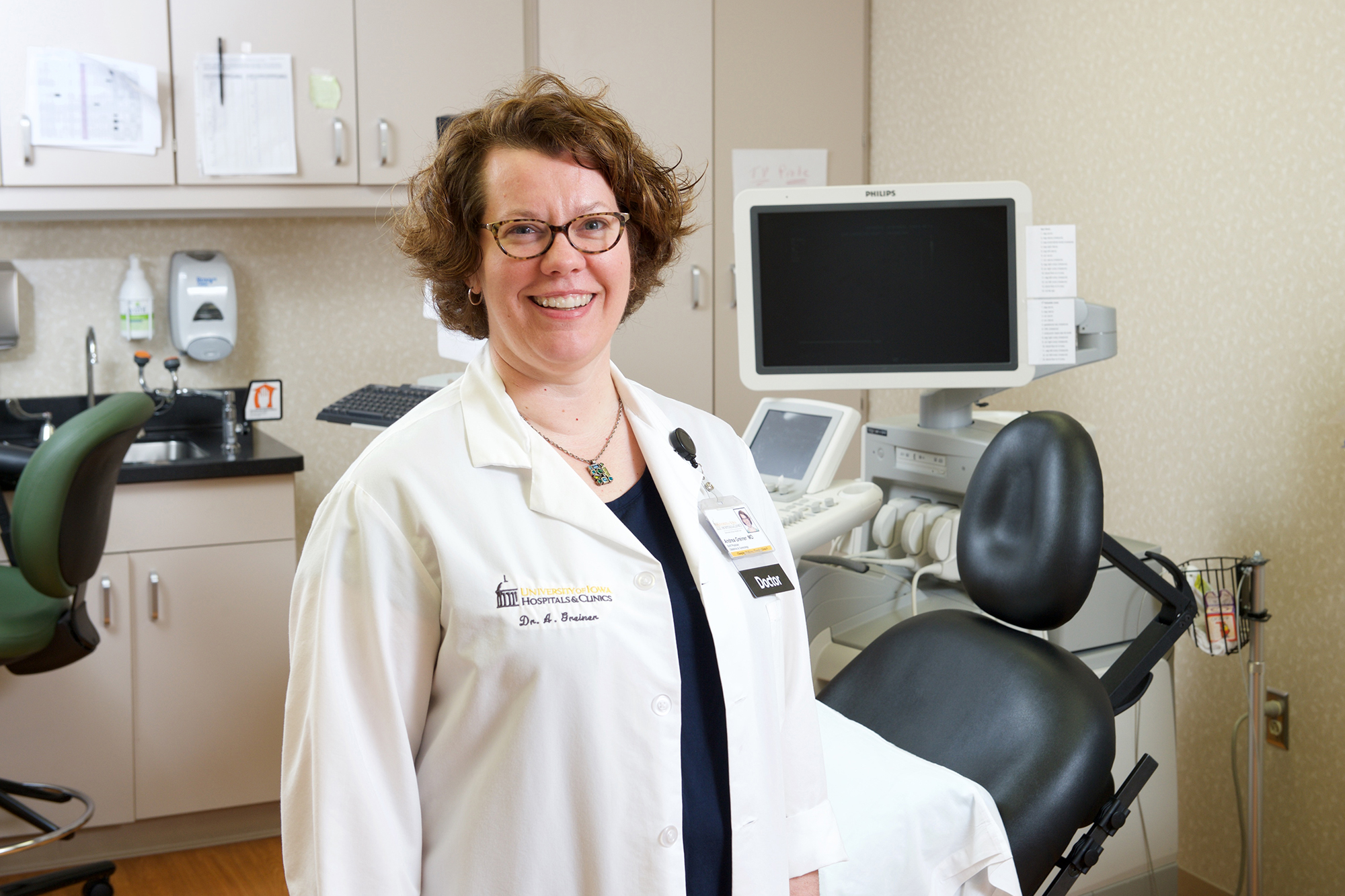
Ob/Gyn
Maternal-fetal medicine (MFM) specialist Andrea Greiner, MD, MHA, says she and her colleagues have been using a form of telehealth for a few years now, virtually seeing patients at clinics in Davenport, Burlington, and Waterloo. There, sonographers who have been specially trained in fetal diagnostics at UI Hospitals & Clinics perform ultrasounds that are watched live by a maternal-fetal medicine doctor in Iowa City, who can then chat with patients in real time, make recommendations for a care plan, and, if necessary, refer them to Iowa City for further high-risk pregnancy care or labor and delivery.
The system worked so well that Greiner says they were planning to expand this hub-and-spoke model to other areas in Iowa through a Health Resources & Services Administration (HRSA) grant before COVID-19 even hit.
“There are few MFM specialists in Iowa, and we often had patients who were referred to us but were not coming to Iowa City,” Greiner says. “It didn’t matter if their local OB said they couldn’t take care of them. They couldn’t get here or afford to come. It’s one way to help reduce that barrier and support patients with complicated pregnancies and their providers.”
COVID-19 quickly ramped up the use of telehealth throughout the Department of Obstetrics and Gynecology, with health care providers using it for care in obstetrics, gynecology, urogynecology, gynecologic cancer, reproductive endocrinology and infertility, and lactation support.
“We can’t do it all through telehealth, but it can be a big win for many. It’s a system in which we can leverage our expertise as high-risk pregnancy physicians without being physically present and the patients don’t have to travel all the way to Iowa City.”
How each area used telehealth varied. Greiner says early visits for low-risk pregnancies could be done via telehealth, but many pregnant patients still needed to be seen in person in order to do an ultrasound or other tests.
“But we could do a lot of follow-up visits through telehealth, such as post-op exams, contraceptive refills, and symptom checks,” Greiner says.
Even though lactation support services can be very hands on, they also found a way to do it via video for new moms.
“The HRSA grant allowed us to buy dolls so a nurse can show the mom what to do and the mom can mimic that,” Greiner says. “A lot of our patients don’t live in Johnson County, and there is very little lactation support the farther away you get from Iowa City. The lactation nurses were excited to try this and be able to continue to serve their patients.”
Along with increasing accessibility and convenience, Greiner sees another potential benefit of telehealth for Iowans.
“A number of hospitals in Iowa have closed their OB services in the last 20 years,” Greiner says. “Through telehealth, we have the potential to partner with local providers, which could allow some patients to be managed locally and only transfer the patients who absolutely need our particular expertise and accompanying support services.”
Greiner says hospitals such as the University of Arkansas for Medical Sciences have shown that their OB telehealth programs keep more patients local by helping manage less-complicated cases without a visit to Little Rock.
“We can’t do it all through telehealth, but it can be a big win for many,” Greiner says. “It’s a system in which we can leverage our expertise as high-risk pregnancy physicians without being physically present and the patients don’t have to travel all the way to Iowa City.”

Mental health
Deb Poole is no stranger to telehealth. The physician assistant who specializes in mental health has worked with people at Grinnell College via telehealth for the past six years, while her colleagues have also provided telehealth to people at Cornell College and area nursing homes.
Early in the COVID-19 pandemic, most students were sent home from campus and were able to continue with care by logging in from home. In some states, however, regulations meant they couldn’t be seen by an Iowa provider.
Poole says their original telehealth system was similar to an in-person visit in that it provided a safety net for people who were in acute danger because there was someone right there who could help if there was an emergency.
When COVID-19 restrictions began, University of Iowa Health Care integrated Vidyo into its Epic electronic medical record system to provide telehealth. To see their health care provider, patients would log in to MyChart and download an app to connect through Vidyo.
Beth Jaggers, administrative director of UI Physician Group at UI Health Care, says the multiple steps required were causing problems with patients being able to successfully connect with their health care providers. Success rates were hovering around 68%.
A recent pilot program using the Epic Native Video—a web browser-based platform that only requires logging into MyChart—proved much simpler for patient and providers to use, gaining a success rate of 93%.
UIHC launched the platform facility-wide the week of Nov. 2, with only a few departments continuing to use Vidyo, including Center for Disability and Development, Child Health Specialty Clinics, Interventional Radiology, and Psychiatry.
Despite that potential challenge, she says telehealth provides psychiatric and follow-up care to people who might not otherwise be able to access it or feel comfortable receiving it in person at a clinic. This is particularly important during the current pandemic, which studies have shown has negatively affected many people’s mental health.
“It’s rare where I feel like we are limited by not seeing someone in person,” Poole says. “It’s sometimes awkward for the first few seconds, but once you get over that, you just start talking and it feels like you’re in the same room with them. For the most part, it feels natural and comfortable. Some people are even more comfortable because they are in their own home.”
Telehealth can remove barriers some patients face, such as living far from a mental health specialist, but it also can help them overcome perceived stigmas about seeking mental health care. Poole says some people find physically going to a clinic appointment to be an important part of taking care of their mental health, while others feel more comfortable visiting with a professional from the privacy of their own home.
“I hope we’ve broken some of the norms and shown we really can provide access to more people and without compromising the care we give,” Poole says.
While the COVID-19 pandemic continues, telehealth has one distinct benefit over an in-person visit.
“In clinic, my patient and I have to wear masks, so we can’t see each other’s faces,” Poole says. “I like seeing patients in telehealth because I can see them and they can see me. You don’t realize how much you miss that until it’s gone.”
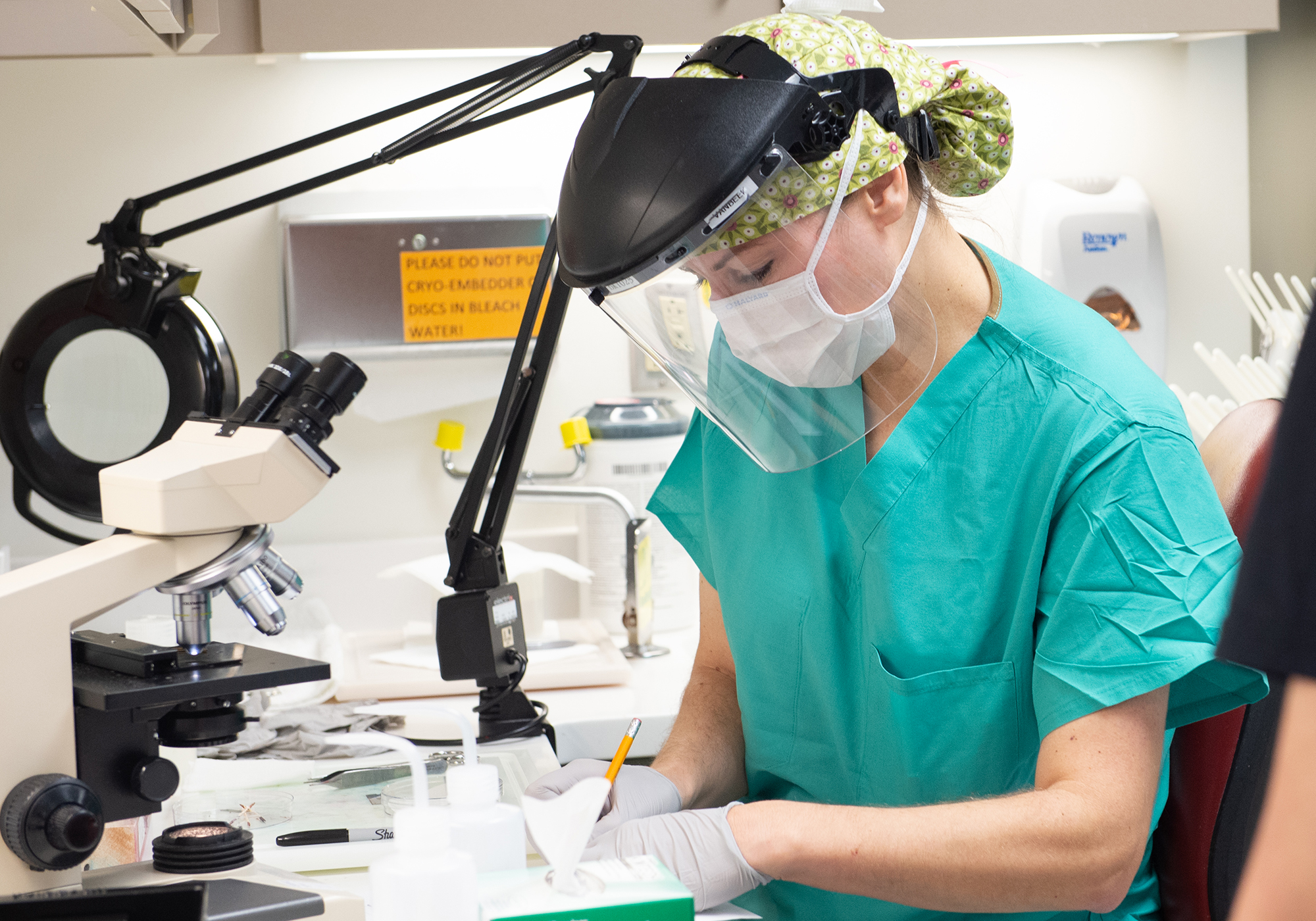
Dermatology
Marta Hemmingson-Van Beek, MD, says dermatologists have been some of the main pioneers of telehealth over the past decades. Still, the dermatologic surgeon and chief of staff says it was mostly being used by her colleagues to consult with primary care providers across the state when they had a question about a patient.
When COVID-19 disrupted in-person visits, they immediately implemented telehealth visits.
“It allowed us to help triage new patients and decide if they needed to be seen in person or have a procedure done, or if they could reschedule their appointments to a later date,” Hemmingson-Van Beek says. “For our regular patients, we can monitor their response to treatment through photos and over video and modify the treatment plan, change medication, or make other recommendations.”
Hemmingson-Van Beek says patients who have had surgery are required to make a number of postoperative visits to ensure they are healing properly.
“Considering many of our patients travel a long way to get care here, telehealth is a win-win, and we expect it to continue post-COVID, especially for postoperative visits, unless someone needs some sort of intervention,” Hemmingson-Van Beek says.
“We’ll do whatever we can for the patient that is most convenient and comfortable, as long as it doesn’t impair the care we provide. Each new generation is more comfortable with technology and has different expectations for how they should receive care, so I expect telehealth to continue to improve and become more popular.”
Dermatology does face a challenge regarding telehealth that some other specialties don’t: needing an in-focus, well-lighted view of the area of concern.
“During a telehealth visit, the patient is the camera operator,” Hemmingson-Van Beek says. “That may not be an issue if it is a diabetes check, but in dermatology, we need to be able to clearly visualize the rash or lesion to accurately assess the disease. It’s also challenging because the patient may decide what area is the most important area to show us. Sometimes there are things that the patient may not think are important that would inform our diagnosis. So, telehealth is often excellent for making sure a patient’s health is being maintained, but as far as making a new diagnosis, sometimes it’s better to see them in person.”
Hemmingson-Van Beek says there are many for-profit organizations that provide dermatology telehealth, but she warns patients to make sure they are being seen by a board-certified dermatologist who is highly trained in evaluating images to avoid inaccurate diagnoses.
Dermatologic surgeons will likely continue to use telehealth visits for postoperative visits on a long-term basis. For other visits, it’s currently up to the provider and patient to decide whether to see each other in person or via telehealth.
Hemmingson-Van Beek says they also are planning a research study to examine patient satisfaction with postoperative telehealth visits.
“We’ll do whatever we can for the patient that is most convenient and comfortable, as long as it doesn’t impair the care we provide,” Hemmingson-Van Beek says. “Each new generation is more comfortable with technology and has different expectations for how they should receive care, so I expect telehealth to continue to improve and become more popular.”
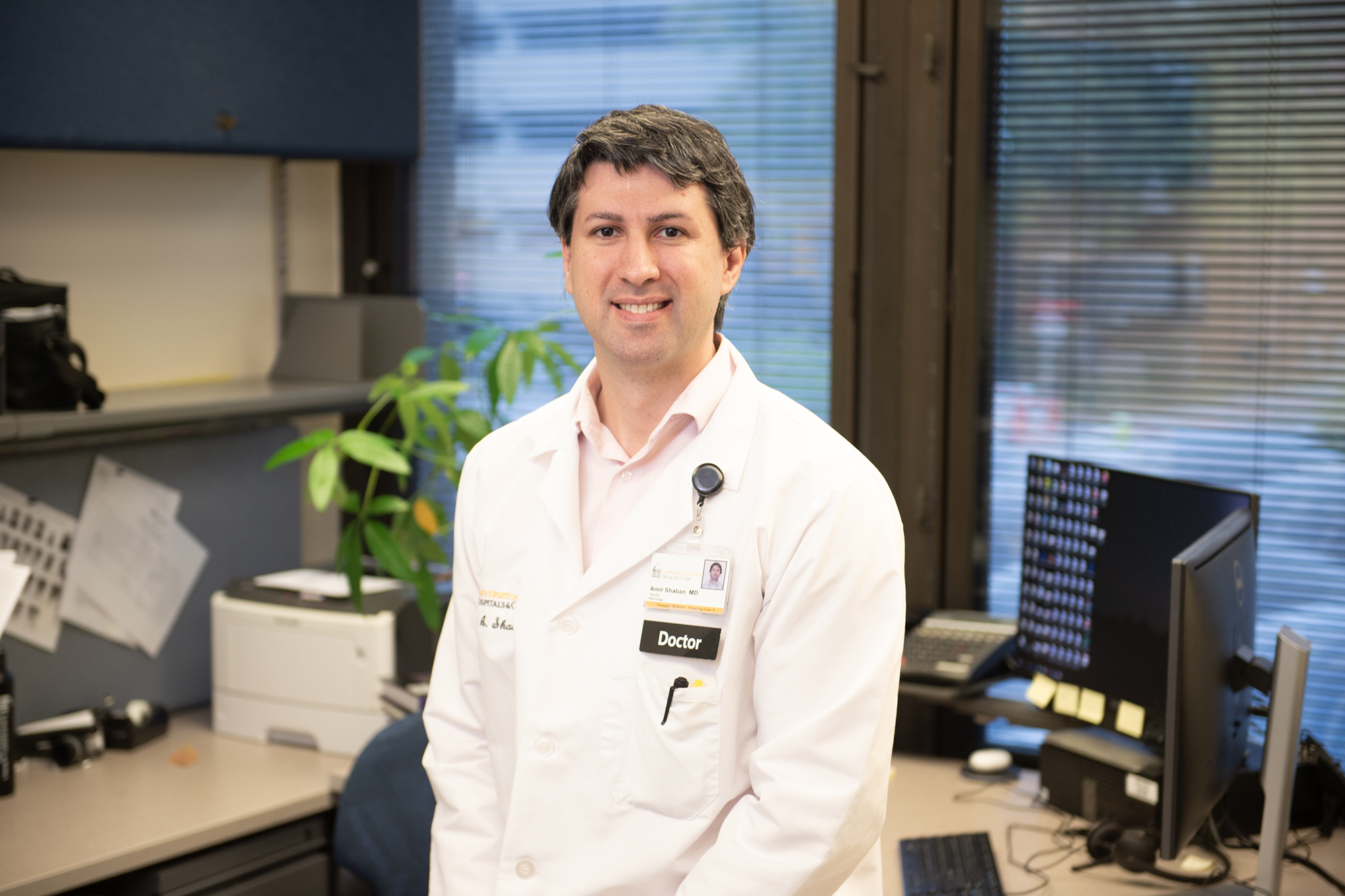
Neurology
The fundamental rule of stroke care is “Time is brain.” The longer therapy is delayed, the less chance it will be successful. This is why UI Hospitals & Clinics neurologists have used telehealth for years to consult with health care providers across the state to care for stroke patients at hospitals that don’t have stroke specialists on staff. They review scans and can advise on treatment, including whether patients can safely stay in their local hospital or need to be transported to Iowa City for more advanced care.
Beyond such emergency consults with providers across the state, telehealth was not used for neurology care before COVID-19. But when safety restrictions meant patients couldn’t come in for their neurology clinic visits, UI neurologists quickly got telehealth off the ground.
“We never want to delay care,” says neurologist Amir Shaban, MD. “Every day that care is delayed may mean missed opportunities for treatment or make a problem less treatable.”
Along with taking a patient’s history, reviewing medications, and discussing symptoms, Shaban says they also can do most of a physical exam if they are meeting via video. To evaluate things such as strength and weakness, function, and sensation, the patient may be asked to hold out their arms, walk toward and away from the camera, or smile.
If labs or tests are needed, the patient will need to come to Iowa City or a local facility. The neurologist can then follow up via phone or video to relay the results and come up with a treatment plan.
All University of Iowa Health Care providers have the capability of performing a telehealth visit—that covers 35 adult specialties and 27 pediatric specialties. Most telehealth appointments are video visits, where you and your provider can meet in a secure, private video call on your smartphone, tablet, or computer.
“While we can’t always do everything that we would during an in-person clinic visit, our patients are getting excellent care using this system,” Shaban says. “I encourage any patient with new neurological complaints to seek medical attention immediately, and I want to assure them that we have the tools to provide the care they need safely during the pandemic.”
Video also played a key role during COVID-19 visitor restrictions at the hospital.
“At times there are critical situations in which important decisions need to be made by family members,” Shaban says. “And a phone call does not cut it all the time.”
Shaban says in those situations, they were able to use a tablet attached to a robot that could virtually bring family into a patient’s room during an exam or to talk through what was happening.
“We tried to make the best out of a very difficult situation,” Shaban says.
While technology presents challenges at times, Shaban says they are able to work through some of them before the appointment by having medical assistants touch base with patients a few days earlier to help them check in to the system and make sure they are able to join the video session. If there are problems, IT is brought in to help. When the appointment time comes, any kinks should have already been worked out.
While the majority of neurology patients are again being seen in person at the clinic, Shaban says he expects telehealth to continue to play a role in neurologic care at UI Hospitals & Clinics.
“It’s a very valuable tool,” Shaban says. “We will always need to see some patients in person, but for others, we can take as good of care of them through telehealth if they need or prefer.
“And it’s nice to have that safety net while the pandemic continues and its impacts are dynamic and changing.”

